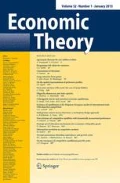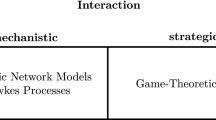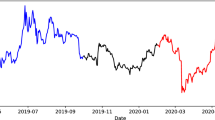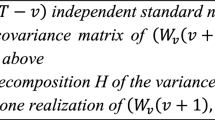Abstract
Consider a one-sector stochastic input–output model with infinite time horizon. The technology in each time period exhibits constant returns to scale on positive linear combinations of a finite number of basic input–output pairs. Furthermore, perfect information is available as a filtration generated by finite partitions of the state space. By definition, competitive prices require expected profit maximization in every time period. The Riesz representation of a sequence of competitive price functionals yields a state-price deflator with a supermartingale property. We show that there exists a competitive price system for some feasible program if and only if there is No Free Production (NFP). Furthermore, there exists a competitive price system for a particular program if and only if if NFP holds and the program is short-run efficient. This model includes a securities market model with or without convex cone trading constraints as a special case. Under these circumstances, NFP reduces to No Arbitrage and we recover a version of the fundamental theorem of asset pricing.
Similar content being viewed by others
References
Alkan A.U. (1980) Efficient programmes for polyhedral technologies are competitive. Rev Econ Stud 47(2): 465–471
Back K., Pliska S.R. (1991) On the fundamental theorem of asset pricing with an infinite state space. J Math Econ 20(1): 1–18
Bertocchi G., Kehagias A. (1995) Efficiency and optimality in stochastic models with production. J Econ Dyn Control 19, 303–325
Elliot R.J. (1982) Stochastic calculus and applications. Springer, New York
Gale D. (1960) The theory of linear economic models. McGraw-Hill, New York
Harrison M.J., Kreps D.M. (1979) Martingales and arbitrage in multiperiod securities markets. J Econ Theory 20, 381–408
Harrison M.J., Pliska S.R. (1981) Martingales and stochastic integrals in the theory of continuous trading. Stoch Process Appl 11, 215–260
Huang K.X.D. (2002) On infinite-horizon minimum-cost hedging under cone constraints. J Econ Dyn Control 27, 283–301
King A.J. (2002) Duality and martingales: a stochastic programming perspective on contingent claims. Math Program Ser B 91, 543–562
Mangasarian O.L. (1969) Nonlinear programming. McGraw-Hill, New York
Majumdar M. (1972) Some general theorems on efficiency prices with an infinite-dimensional commodity space. J Econ Theory 5, 1–13
Majumdar M. (1974) Efficient programs in infinite dimensional spaces— complete characterization. J Econ Theory 7(4): 355–369
Majumdar M., Mitra T., McFadden D. (1976) On Efficiency and Pareto optimality of competitive programs in closed multisector models. J Econ Theory 13, 26–46
Malinvaud E. (1953) Capital accumulation and efficient allocation of resources. Econometrica 21, 233–268
Malinvaud E. (1962) Efficient capital accumulation: a corrigendum. Econometrica 30, 570–573
McFadden D. (1975) An example of the nonexistence of Malinvaud prices in a tight economy. J Math Econ 2, 17–19
Mitra M., Majumdar M. (1976) A note on the role of the transversality condition in signaling capital overaccumulation. J Econ Theory 13, 47–57
Peleg B., Yaari M. (1970) Efficiency prices in an infinite-dimensional space. J Econ Theory 2, 41–85
Radner R. (1967) Efficiency prices for infinite horizon production programmes. Rev Econ Stud 34(1): 51–66
Ross S. (1978) A simple approach to the valuation of risky streams. J Bus 51(3): 453–485
Santos M., Woodford M. (1997) Rational asset pricing bubbles. Econometrica 65, 19–57
Schachermayer W. (1994) Martingale measures for discrete-time processes with infinite horizon. Math Finance 3, 43–53
Taqqu M.S., Willinger W. (1987) The analysis of finite security markets using martingales. Adv Appl Probl 19, 1–25
Zilcha I. (1992) Efficiency in economic growth models under uncertainty. J Econ Dyn Control 16, 27–38
Author information
Authors and Affiliations
Corresponding author
Additional information
The author expresses gratitude for the advice of two anonymous referees, one who pointed out the simple way to prove the key lemma and the other who helped integrate the conclusions into the existent literature.
Rights and permissions
About this article
Cite this article
Clark, S.A. Competitive prices for a stochastic input–output model with infinite time horizon. Economic Theory 35, 1–17 (2008). https://doi.org/10.1007/s00199-007-0225-8
Received:
Revised:
Published:
Issue Date:
DOI: https://doi.org/10.1007/s00199-007-0225-8




